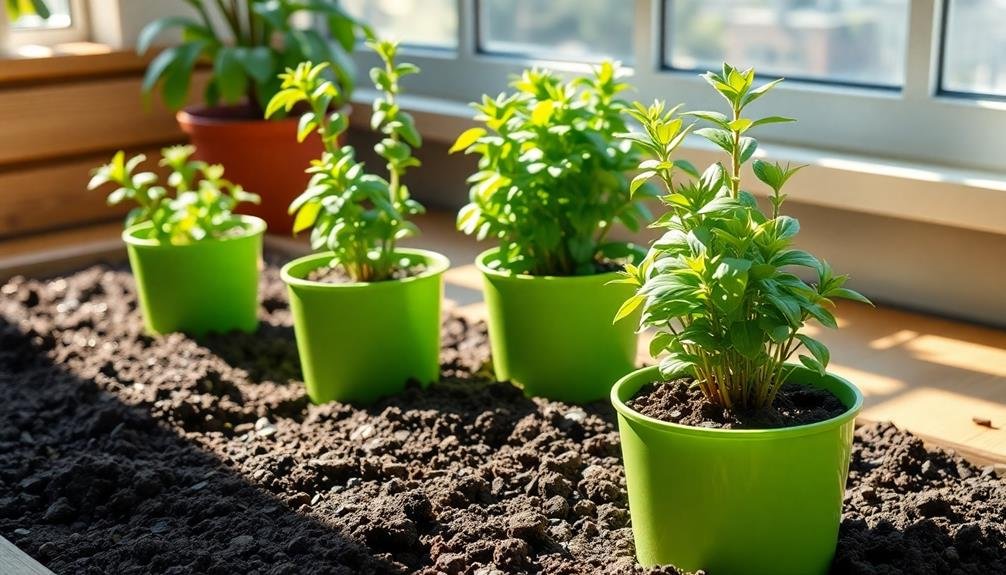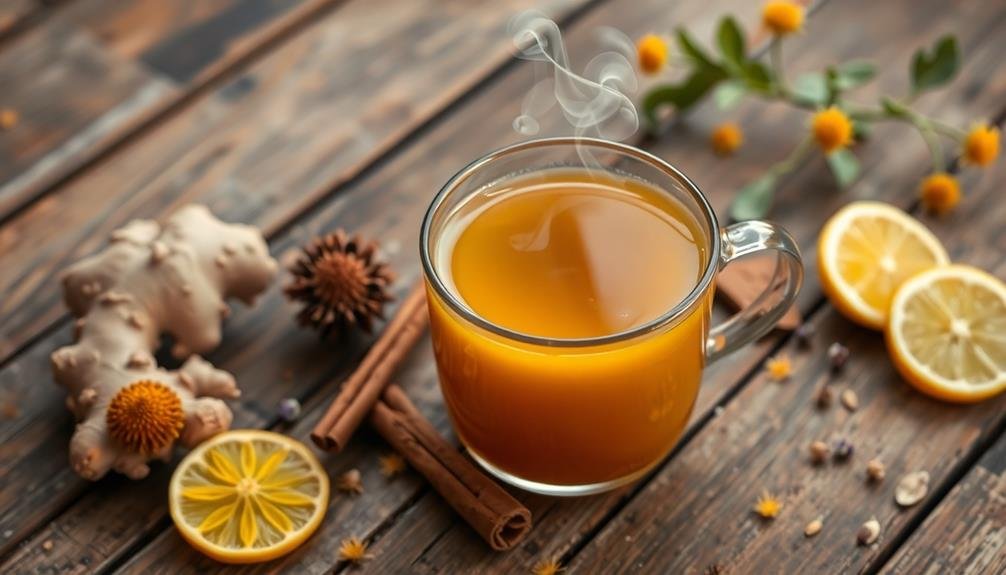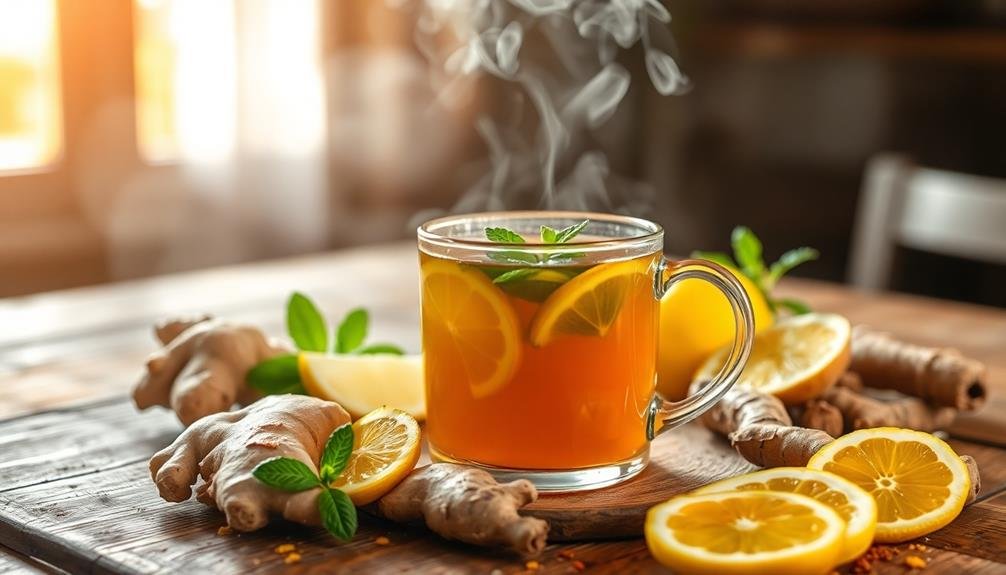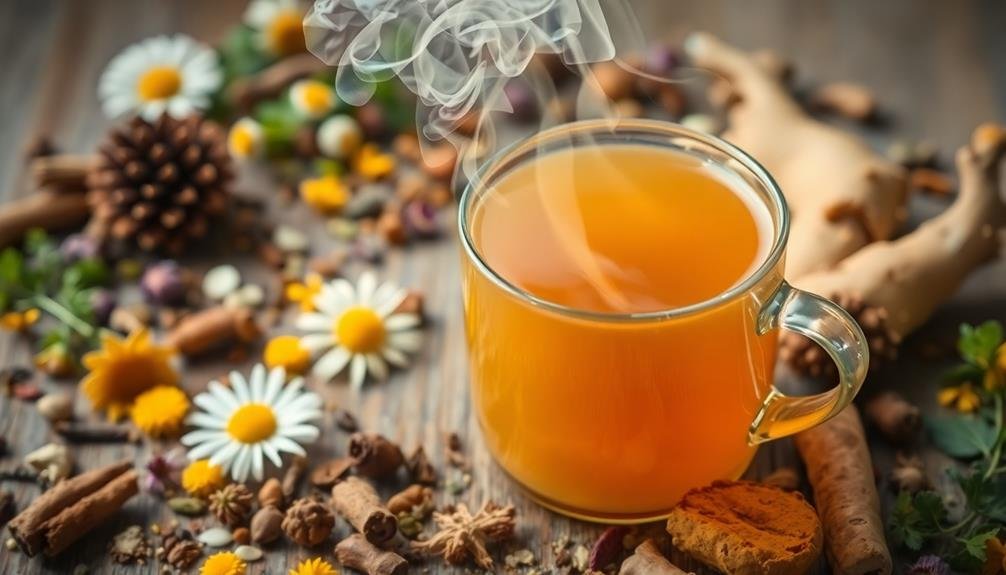To grow delicious tea herbs indoors, you've got some great soil options. Start with an organic potting mix for excellent drainage and nutrients. A peat-based blend works well too, retaining moisture while allowing aeration. Consider a coconut coir mixture for its eco-friendly benefits and moisture retention. For superior drainage, blend vermiculite and perlite to create a light, porous environment. Finally, you can craft a custom DIY soil recipe by mixing potting soil and compost, adding aeration boosters, and a touch of peat moss. Explore these blends further to find which one best suits your growing needs!
Organic Potting Mix

When growing tea herbs indoors, choosing the right organic potting mix is essential for success. You'll want a blend that provides good drainage, aeration, and nutrition. Look for a mix specifically designed for herbs or vegetables, as these usually contain the right balance of ingredients.
A quality organic potting mix typically includes components like compost, coconut coir, and perlite or vermiculite. Compost enriches the soil with nutrients, while coconut coir retains moisture without suffocating the roots. Perlite or vermiculite improves drainage and air circulation, preventing root rot.
Before planting, verify your pot has adequate drainage holes to allow excess water to escape. You might also consider adding a slow-release organic fertilizer to give your tea herbs a nutrient boost throughout their growth.
Avoid mixes with synthetic additives or chemicals, as these can harm your plants and compromise the quality of your tea.
By investing in a high-quality organic potting mix, you'll create an ideal environment for your tea herbs to thrive, guaranteeing a bountiful harvest for your brewing pleasure.
Happy gardening!
Peat-Based Soil Blend
While many gardeners prefer organic potting mixes, a peat-based soil blend can also be an excellent choice for growing tea herbs indoors. This type of soil is lightweight and provides good aeration, which is essential for healthy root development.
Peat moss retains moisture effectively, ensuring your tea herbs have consistent access to water without becoming waterlogged.
When using a peat-based blend, it's vital to take into account its pH level, as many tea herbs thrive in slightly acidic conditions. You can adjust the pH by incorporating additives like sulfur if needed.
Additionally, mixing in perlite or vermiculite can enhance drainage and further improve the structure of the soil.
Keep in mind that while peat-based soils are beneficial, they can be less sustainable than other options, as peat harvesting has environmental impacts.
To mitigate this, look for blends that use sustainably sourced peat or consider mixing it with other organic materials.
Coconut Coir Mixture

Coconut coir, a sustainable alternative to peat, offers an excellent mixture for growing tea herbs indoors. This natural fiber, derived from coconut husks, provides remarkable aeration and drainage, guaranteeing your tea herbs thrive without waterlogging.
When you use coconut coir, you'll notice how it retains moisture better than many other substrates. This moisture retention is ideal for maintaining the humidity levels that tea herbs love.
To create an ideal coconut coir mixture, combine coir with compost or well-rotted manure. This blend not only boosts nutrient content but also encourages healthy microbial activity in the soil, fostering vibrant plant growth.
You can also add a touch of lime to balance the pH levels, making it more suitable for your tea herbs.
Keep in mind that coconut coir can be slightly alkaline, so checking the pH before planting is wise. Adjusting the mixture to a pH range of 6.0 to 6.8 guarantees your herbs flourish.
With this mixture, you're setting the stage for a successful indoor tea herb garden that's both eco-friendly and effective. Enjoy nurturing your plants and savoring the benefits of fresh tea!
Vermiculite and Perlite Blend
Creating the perfect growing environment for tea herbs involves understanding the importance of aeration and drainage, which is where a vermiculite and perlite blend shines.
Both vermiculite and perlite are excellent additives that enhance soil structure, making it lighter and more porous. This combination allows roots to breathe while efficiently draining excess water, preventing root rot.
When you use a vermiculite and perlite blend, you're ensuring your tea herbs have the right conditions to thrive.
Vermiculite retains moisture and nutrients, acting like a sponge, while perlite provides essential aeration. Together, they create a balanced environment that supports healthy root development.
To prepare your blend, you can mix equal parts of vermiculite and perlite into your potting soil.
Adjust the ratio based on your specific tea herb's needs; for example, if you're growing herbs that prefer drier conditions, increase the perlite.
Remember, a well-draining soil mix promotes robust growth and vibrant flavor in your tea herbs.
Using this blend will set you up for success, giving your indoor tea herbs the best chance to flourish and produce aromatic leaves.
Custom DIY Soil Recipe

A custom DIY soil recipe can make all the difference in nurturing your tea herbs indoors. Start by mixing equal parts of high-quality potting soil and compost. This combination provides essential nutrients while guaranteeing good drainage.
Next, add perlite or vermiculite to the mix—about one part per three parts soil. This addition improves aeration and prevents soil compaction, which is vital for healthy root development.
To further enhance your soil, consider incorporating a handful of organic matter, like worm castings or well-rotted manure. These enrich the soil with beneficial microorganisms.
If you're growing herbs that prefer slightly acidic conditions, you can also mix in a small amount of peat moss. This will help lower the pH and create a more favorable environment for your tea plants.
Lastly, don't forget to add a slow-release organic fertilizer to provide ongoing nourishment. Mix it thoroughly into your soil blend to guarantee even distribution.
With this custom DIY soil recipe, you'll create a favorable environment for your tea herbs, promoting lush growth and vibrant flavors. Make sure to monitor moisture levels and adjust as necessary to keep your herbs thriving.
Frequently Asked Questions
How Often Should I Water Tea Herbs in Indoor Soil Blends?
You should water your tea herbs when the top inch of soil feels dry. Depending on humidity and light, that might be every few days to a week. Always guarantee the pot has proper drainage.
Can I Use Regular Garden Soil for Growing Tea Herbs Indoors?
You shouldn't use regular garden soil for growing tea herbs indoors. It often lacks proper drainage and nutrients. Instead, opt for a well-draining mix designed for container plants to guarantee healthy growth and development.
What Type of Containers Are Best for Indoor Tea Herb Growth?
When choosing containers for indoor tea herbs, opt for pots with good drainage and at least six inches deep. You'll want materials like clay or plastic that retain moisture without becoming waterlogged.
How Much Sunlight Do Indoor Tea Herbs Require?
Indoor tea herbs thrive with about six hours of indirect sunlight daily. You should place them near a window but avoid direct rays, as too much sun can scorch their leaves and stunt growth.
Are There Specific Fertilizers Recommended for Tea Herbs in Pots?
When growing tea herbs in pots, you'll want to use a balanced, water-soluble fertilizer. Look for one with equal parts nitrogen, phosphorus, and potassium, applying it every four to six weeks for ideal growth.
In Summary
In summary, choosing the right soil blend is essential for successfully growing tea herbs indoors. Whether you opt for an organic potting mix, a peat-based blend, or create your own custom recipe, each option offers unique benefits. Experiment with these blends to find what works best for your specific herbs and growing conditions. With the right soil, you'll be well on your way to enjoying a thriving indoor tea garden. Happy gardening!





Leave a Reply